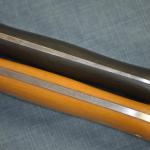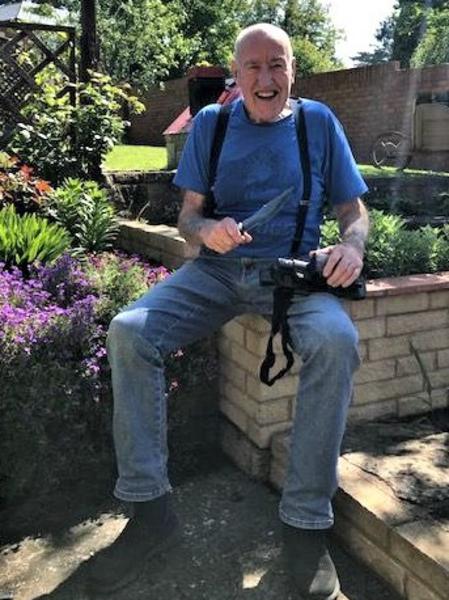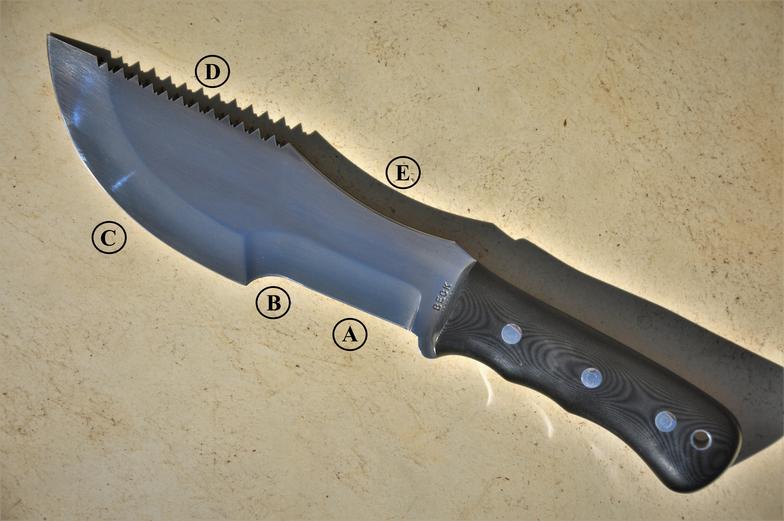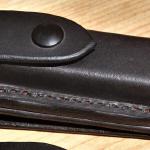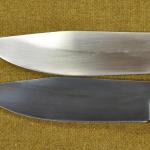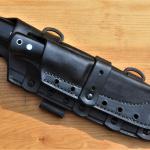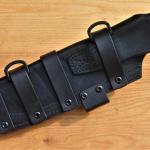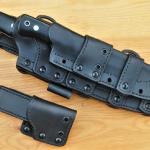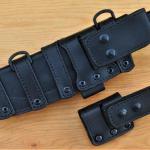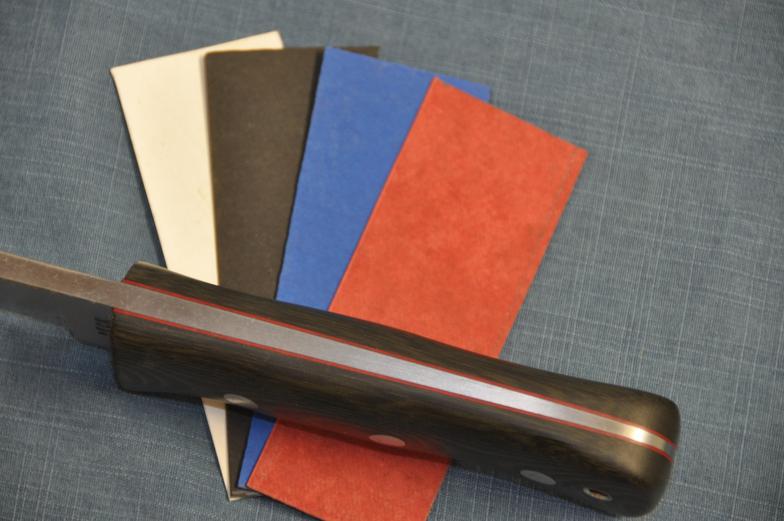David R. Beck, Knifesmith LLC
Call Us: +1-610-670-5319
"Fine Cutlery for the Adventurer"
The Original Beck Tracker/WSK (Wilderness Survival Knives)
Click on thumbnails below to enlarge & for captions of features & options available for our WSK knives.
-----------------------------------------------------------------------------------------------------------------------------------------------------------
Tracker/WSK knife models & options:
Tracker/WSK knife availability.
Our Tracker/WSK knives are entirely hand-crafted & laborious to produce. All are made-to-order so we normally don't have any in stock for immediate purchase. Only about 24-30 total Tracker/WSK knives are made per year. Once our quota is full, no additional orders will be accepted until the following year.
*Refer to our "Finished Knives For Sale" page to view all knife models currently available for immediate purchase.
(Right): John "Lofty" Wiseman
Author of the "SAS Survival Handbook" A legend, personal friend, and proud user of one our model "G" WSK knives.
Hope to see you on the trail.
David R. Beck on an adventure atop Angel's Landing, Utah
(Left) #SS1 Adjustable Shoulder Strap:
Made from 1" x 8' tubular Sterling climber's webbing w/mil-spec nylon Nexus hardware. 4000lb. safety-rated (w/out hardware). Webbing can be used to fabricate an emergency safety harness, but hardware must first be removed. Attaches to scout loops w/D-rings. (5oz.)
Price = $25.00 (+ shipping)
Tracker/WSK blade anatomy
(A) Draw Knife Edge: The sharpest, & most delicate edge for
general carving, shaping & scraping. Originally hollow
ground, but later changed to a flat-grind (shown) to provide
greater edge support.
(B) 1/4-Round: Used as a gut hook & for carving/scraping trap
parts & arrow shafts.
(C) Hatchet: Flat-ground for chopping, scraping & the only
edge that should be used when splitting woods. Correctly
angled so the strongest part of the blade forward of the
1/4-round" delivers the impact for greater edge safety &
penetration.
(D) Saw Teeth: "Swiss Army" type staggered tooth design is
self-cleaning & aggressive cutting on both the pull & push
stroke. Used for cutting square notches, or tilt at a 45
degree angle to cut "V" grooves (both used for traps &
snares). The downward angle enables sawing square &
"V" grooves on flat surfaces & stakes for trip & snare wire
channels.
(E) Spine Recess: Specifically designed as a striking point when
splitting woods & for push-carving. The curved surface
enables the blade to be rocked or tilted at any angle & still
receive direct energy into the material being worked.
Recess edges are lightly de-burred to avoid thumb abrasion
while carving but can be requested with sharp edges if
needed for scraping tasks.
Although additional benefits have been discovered by others, the anatomy details to the right explain what these knife features were originally designed for.
-------------------------------------------------------------------------------------------------------------------------------------------------------------
Answers to Frequently Asked Questions Regarding Tracker/WSK knives:
* Basic care & use tips are supplied w/every knife, but should a customer not find an adequate answer in the printouts supplied, please contact us for more info.
We're happy to share info & assist our customers in any way we can.
* Our knives are designed to be efficient cutting tools & should be treated as such. They are designed to cut wood, fiber, flesh & similar materials. Although plenty
strong for their intended purposes, they are not indestructible. Our knives are tested beyond the standards of reasonable use to help ensure user safety under
"normal" conditions, but, as with any knife, the more unnecessary abuse your knife receives, the greater risk of premature wear, damage, or injury.
* Chopping/splitting should ONLY be done using the hatchet edge & not the finer draw knife or 1/4-round edges.
* Don't chop bone, & never cut, or chop directly on the ground to avoid edge damage.
* Don't beat on the saw teeth! Although they will hold up well, damaged saw teeth can be very costly to fix & will often alter the appearance of the blade.
* Batoning, or the splitting of wood by pounding on the back of a knife is a task which is common practice today rather than reserved for true survival situations.
We do not recommend batoning only because your interpretation of what may be acceptable force could be quite different from what our knives are tested to
endure. A true, survival situation is one thing, but if you need to split firewood or build a cabin use an axe & your knife will thank you.
* Don't throw or use your knife as a pry bar. (NO, our knives are not designed to fly straight like seen in the "HUNTED" movie.)
* Keep your blades clean & oiled, or better, waxed for those in wet or coastal environments to help ward off rust.
* Don't use diamond stones or grinders for sharpening. On carbon steel blades these remove unnecessary material & lessen blade life. We recommend a hard
Arkansas stone w/light oil or water. For the finest edge maintenance, a simple stropping on leather w/a little fine rouge to polish is generally sufficient.
The key to a sharp edge in not the removal of metal but keeping the edge finely polished.
Stone use should be reserved for very dull, overworked edges, or for removing minor nicks & edge imperfections.
* Apply common sense in use & your knife will give you a lifetime of dependable service.
* Refer to the printed materials your receive with your knife & our "Terms, Conditions & Warranty" page for more info on recommended use, services & product
coverage.
(Left) Wet-sanded vs. blued finishes.
(Left) #SP1 Sharpening Stone Pouch:
Black molded leather w/heavy duty mil.-spec snap closure. Fits a 1/2 x 1 x 4" stone w/enough room for up to a 1/16" thick ferro rod striker blade. Comes with removable belt loop for separate carry but requires two mounting straps to attach to a sheath. (4oz.)
Shown attached to the mounting straps of a Tracker type-2 sheath.
*Stone not included but a #FAP-14AT hard Arkansas stone can be purchased from Dan's Wetstone. Price = $85.00 (+ shipping)
(Left) "Type-1" WSK sheath: (Example shown fully-dressed out with all options &
companion knife added to demonstrate set-up capabilities).
Options: (*All add-on options come with blackened steel mounting screws.)
(A) Mounting holes: Unlined but coated inside w/a protective finish. No charge.
Automatically installed for options ordered, or request full-series for more versatility.
(B) 1" Horizontal-carry "scout" loops w/D-rings (2oz.) = $20.00 (per set of two)
(C) 1" Mounting straps to add companion knife or pouch (2oz.) = $20.00 (per set of two)
(D) Brass-lined leg tie/lashing holes = $15.00 (per two)
(E) Full mounting package (includes options A, B, C & D) 4oz. = $45.00 (best deal)
(F). #FRL 3/8 x 1-1/2" Kydex ferro rod loop w/mounting screws (1/2oz.) = $20.00
*Spare mounting screws (contact to order right length) = $0.50 (1 screw & 1 post).
*See below for info on adding a companion knife.
(Left) "Type-2" WSK sheath: (Example shown fully dressed out with all options and
companion knife added to demonstrate set-up capabilities).
Note: Type-2 sheaths have full ambidextrous capabilities, but the vertical belt loop
assembly (panel part for belt loop) is right or left hand only.
*Comes std. as a sheath body only. You add only the options you needed.
Options: (*All add-on options come w/decorative edge stitching & blackened steel
mounting screws).
(A) Mounting holes: Unlined but coated inside w/a protective finish. No charge.
Automatically installed for options ordered, or request full-series for versatility.
(B) Belt loop assembly (5oz.) = $90.00 (Not included in mounting package)
(C) 1" Horizontal-carry "scout" loops w/D-rings (2oz.) = $25.00 (per set of two)
(D) 1" Ambidextrous mounting straps to add companion knife or pouch (2oz.)
= $25.00 (per set of two)
(E) 1-7/8 upper "stirrup" mounting strap (R or L hand, for more rigid companion knife
or pouch attachment) 1-1/2oz. = $15.00 (only one needed)
(F) Brass-lined leg tie/lashing holes = $15.00 (per two)
(G) Full mounting package (includes options A, C, D, E & F) 5-1/2oz. = $65.00 (deal)
(H) #FRL 3/8 x 1-1/2" Kydex ferro rod loop w/mounting screws (1/2oz.) = $20.00
* Spare mounting screws (contact to order correct lengths) + $0.50 (1 screw & 1 post)
* See below for info on adding a companion knife.
(LEFT) #G2WSKHD Model "G" Gen2 Tracker/WSK knife:
Our personal favorite for optimum feel, grip & handling. Shown with a wet-sanded finish & unpolished black linen Micarta handle w/std. stainless steel Loveless bolts & lined lanyard hole. 1/4 x 7-1/4" differentially heat treated 01 high carbon steel blade w/flat-ground bevels, standard saw teeth & tapered tang.
12-1/2" OAL. Carry wt. approx. 1lb. 13oz.
WE ARE NOW EXCEPTING A LIMITED NUMBER OF ORDERS
Price = $1,625.00 + shipping.
Above: A Dave Beck model "C" Gen1 Tracker
knife as made for the "HUNTED".
Sheath styles available our knives:
* The prices for all knives include the cost of either a Traditional, or Type-1 sheath ("Basic-style" w/out "scout" loops).
For a fancier option you can fully-customize, our top-of-the-line Type-2 sheath body can be substituted. The type-2 includes the
body only. You build upon the sheath by adding only the options you want at an extra cost.
Tracker/WSK sheaths are crafted from 10/11oz. molded bridle leather. All other sheaths are 8/9oz. molded bridle leather.
*Sheaths are presently only available in durable black bridle leather.
*We can fabricate new sheaths for existing knives made by us, but because every sheath is molded for each individual knife to ensure
the best fit, it is required that you send us your knife in order to have a sheath made.
< Left: Traditional (original-style) sheath.
Shown w/optional fixed "scout" loops added upon request at
no extra cost. Specify right or left hand version when ordering.
*Cannot be modified for "piggyback-mounting" of a smaller
"companion" knife.
*Replacement sheath cost (If purchased for an existing
knife) 11oz. Price = $95.00 (+ shipping)
< Left: Type-1 sheath. "Basic" version.
Fixed belt loop w/modular capabilities.
Specify right or left hand version when ordering.
Can be modified for horizontal "Scout" carry & "piggyback"
attachment of a smaller companion knife sheath or pouch.
*Replacement sheath cost (If purchasing for an existing knife)
12oz. Price = $95.00 (+shipping & any added options)
*See below for available add-on options at an extra cost.
< Left: Type-2 sheath (Body only).
Fully customizable with ambidextrous capabilities.
Starts with a molded leather body & you add only the options
you want. "Basic" version shown w/ a belt loop assembly added
for extra cost. All Strap & loop options have fancy edge stitching.
Replacement sheath body (if purchasing for an existing knife)
9oz. = $85.00 (+ shipping & any added options)
*See below for available add-on options.
How to order:
1. Email us with your name, mailing address & phone number.
2. Include the knife model, blade finish, handle material, sheath type, right or left-hand orientation, & list any available sheath
options you'd like to include. We'll reply within 24hrs. to confirm placement of your order, your order details, what the total
cost will be when completed, & an estimated completion time when your knife will be finished.
3. NO deposit is required to place an order, but payment must be received in full within 7-days from the date you're notified
your knife if finished & ready to ship. Payment method would be arranged when you receive your order completion notice.
< Left: An original "Medicine Blade" produced by
Ed Lombi.
(Above) #C3WSKHD (Model "C" Gen3 Tracker/WSK knife):
Our most popular model "C" pattern featuring all the upgraded design performance enhancements requested by professional users.
Shown with a wet-sanded blade finish & unpolished black linen Micarta handle w/std. stainless steel Loveless bolts & lined lanyard hole. 1/4 x 6-3/4" differentially heat treated 01 high carbon steel blade w/flat-ground bevels, standard saw teeth, tapered tang, & dual-position grip handle. 12-7/8" OAL Carry weight approx. 1lb. 13oz.
WE ARE NOW ACCEPTING A LIMITED NUMBER OF ORDERS Price = $1,700.00 + shipping.
(Above) #SWSKHD (Model "S" Tracker/WSK knife):
Our latest pattern sporting the much-desired "Saranac-style" handle designed for comfortable grip & control.
Shown with a wet-sanded finish & polished black linen Micarta handle w/std. stainless steel Loveless bolts & lined lanyard hole.
1/4 x 7-1/4" differentially heat treated 01 high carbon steel blade w/flat-ground bevels, standard saw teeth & tapered tang.
12-5/8" OAL. Carry weight approx. 1lb. 13oz.
*Note: The pic shown is of an older prototype model "S". Current versions being produced have higher blade bevel lines as shown in the above model "C" Gen3 Tracker/WSK knife image, & forward handle contouring like on our model "G" (below) for better grip.
*This pic will be replaced with the updated version as soon as an example showing current features is available to photograph.
WE ARE NOW ACCEPTING A LIMITED NUMBER OF ORDERS Price = $1,700.00 + shipping.
Handle material choices:
(Note: Handle samples shown demonstrate typical color representation from our suppliers, but be aware that exact color tones can sometimes vary slightly from one manufacturer's batch to the next.)
*Handles are secured by epoxy AND stainless steel Loveless bolts w/lined lanyard holes.
*Ivory/bone & other light-colored Micarta scales are not recommended on blued knife blades as discoloration around the tang can
sometimes occur from touch-up bluing transfer during final finishing which can be difficult to remove.
*Linen & burlap Micarta handles come std. w/a finely-sanded but unpolished finish for better grip & less glare, but can upon request
be polished at no extra cost. Paper Micarta & RichLite scales are made std. with a polished finish for the best appearance, but can be
left unpolished upon request.
< Black linen Micarta
< OD Green linen
Micarta
< Tan linen Micarta
(Not Available)
< Green & black
linen Micarta
< Maroon (burgundy)
linen Micarta
(*$10.00 Extra cost)
< Burlap Micarta
(*$15.00 Extra cost)
Above: Colored handle spacers: Add $10.00
Available in black, white, red or blue.
Above: Polished black paper Micarta
Above: Antique (linear) "ivory" paper Micarta
"Companion" knives:
A smaller 4" bladed knife can be attached to the front of a either a Type-1 or 2 Tracker/WSK knife sheath for the perfect all-around 2-knife set to address every cutting task. All are available to order with the same options to match our Tracker/WSK knives.
*Refer to our "Made-to-Order Knives" page to view compatible options along with other knives we offer.
For those searching for a real "Tracker" knife you've come to the right place.
In 1989 we were approached by Tom Brown to fabricate a unique knife for the students of his famous Wilderness Survival, Tracking
& Nature Awareness School. The knife we were presented with was conceived in 1981 by Rob Russon whom deserves credit for the original concept, but at the time his pattern was only being produced by Ed Lombi, which was then named the "Medicine Blade".
With Mr. Lombi now looking at retirement, his knives became very difficult to obtain so a new maker was being sought.
The idea of this design was to create a stand-alone knife capable of performing a broad range of tasks for primitive survival. Developing such a design wasn't easy as compromises needed to be considered. The knife wasn't expected to perform better than a tool more dedicated to a single task, but accomplish a many uses well enough to eliminate the need for carrying multiple tools in the field. What the design lacked in task-specific performance was intended to be compensated for through well-practiced skills.
Offering our own experience & concepts for design improvements to enhance effectiveness & efficiency, we agreed to take over the project after being presented with the opportunity.
In 1991, we opened our first full-time knife shop to better serve the "tracker" community with our newly-designed model A, B, C, D & E pattern knives. At the same time we also became the first & only maker to own the "TRACKER" trademark (issued to David R. Beck by the US Patent & Trade Office) which was stamped into our blades, & the official TRACKER Wilderness Survival Knife was born.
For the next ten years we produced these & other custom variations of our own design for Elite military, survival instructors, Search & Rescue personnel, celebrities, & outdoorsmen from around the world. We were the first to add the staggered "Swiss Army" style self-cleaning saw teeth to the back of our knives, & we were also solely responsible for designing the model "C" pattern which was soon to become so famous & start the "Tracker" knife craze years later after its exposure on the international scene.
In the late '90's, a proposal for a partnership, & ideas for mass-production to better meet the growing demand within Tom's school was introduced. Feeling this would sacrifice quality & the control over design improvements we believed were more important than profit, we opted to continue making our knives by hand, while Tom began searching for a commercial manufacturer who could produce his version on a much larger scale to be marketed through his school.
Unfortunately for us, the conflict of ideas, & our lack of marketing skills soon resulted in loss of sales forcing us to close our doors, which also resulted in us losing our exclusive rights to the TRACKER trademark with the US Patent & Trade office which now became open domain for all to use.
When the prospect of a Hollywood movie arose wanting to feature the knife in a dominant role, Tom found a partnership with TOPS knives, but his own knife version wouldn't be ready in time for the filming, so an already proven & available knife, one of our model "C" Gen1 TRACKER knives was selected instead, making our knife the one that was seen & used by Benicio Del Toro in the 2003 Paramount Pictures movie the HUNTED. After its release, the TOPS/Tom Brown knife became an good entry-level alternative, & at cost many could afford, but broad miss-representation to promote sales confused buyers after they began receiving a knife that looked different than what was viewed on screen. The fact is, although their knife was a good substitute for average users less concerned about more refined features, the TOPS/Tom Brown knife never had any part or influence in the HUNTED movie at all. To further complicate things, our name was omitted from the movie credits as being the maker, we speculate, to keep the public in the dark for a marketing advantage. This all fueled much debate among collectors over who really designed & made the actual movie knife. When the knife started receiving international attention, many outside of the Tracker School circle really weren't familiar with our name or the knife's history, so it became quite a task for us to establish ourselves & gain recognition for our work.
With the now world-wide exposure of our knife playing a major role in the movie, more years to refine our knives to a higher level of quality & performance, better marketing skills, & collectors searching for the real TRACKER knife from the HUNTED, we felt a better chance for success & resumed manufacturing. But, due to competitive pushback making it impossible to afford trying to reclaim exclusive use of the original TRACKER trademark, in 2003 we instead chose to change the name to simply "WSK" (Wilderness Survival Knife). A name for this style of knives we were the first to coin but also later copied by so many other makers.
The venture didn't last long, for personal injury again forced our closure when we weren't able to produce knives for several years to follow. 2011 everything finally fell into place. With regained health & so many beating on our doors looking for a real "Tracker" knife, we re-opened, resuming full-time knife manufacturing but now under the new business name of David R. Beck Knifesmith LLC.
David R Beck-made Tracker knives today:
Since 1989, our Tracker/WSK knives have been the choice of many professional outdoorsmen, & have also been deployed in many of the world's conflicts by Elite Special Operations personnel from around the globe. What as once only designed as a highly useful bushcrafting/survival tool has also proved their value being very effective under the most demanding combat environments.
Today, all our Tracker/WSK knives continue to be entirely hand-crafted at our workshop. While there are now many makers offering their own interpretation of the Tracker/WSK knife concept, none can claim more experience, having crafted more by hand, or know these knives better than us. Having evolved from over 35-years of refinement & field use, our knives are simply the best-designed & made you'll find anywhere, & are the only ones collectors seek due to their high investment return value.
When you purchase one of our Tracker/WSK knives you not only get a lot of history behind it, but you can be confident the knife held in your hand will deliver the best quality, feel, performance & reliability for a lifetime of service. You will also be supporting small business & a truly "Made In The USA" product that's time-proven to be the "Gold-Standard" by which all others are compared.
All our Tracker/WSK knives are produced with the following features:
*Every knife & sheath is entirely hand-crafted by David R Beck & we're proud say everything is "MADE IN THE USA".
*Differentially heat-treated 01 high carbon steel blades for superior edge retention & ease of sharpening in the field.
*Hand-cut, non-clogging "Swiss Army" style staggered saw teeth for aggressive cutting on both the pull & push stroke.
*Ergonomically-shaped handles for extended use comfort & enhanced grip, secured by strong stainless steel Loveless bolts & a
lined lanyard hole.
*Hand-crafted sheaths wet-molded from durable leather, double-stitched for strength, & coated with a protective oil/wax finish.
*Available options include your choice of blade finish, handle material, sheath style, & sheath add-on options to enable
customizing a knife kit to suit your personal needs.
*All hardware (snaps, screws, rivets, D-rings, etc.) are made from durable Mil-spec grade components.
*Prices for all knives include the cost of a "Basic" styled sheath. Sheath upgrades & add-options are available at an extra cost.
*All knives come with our 5-day money-back satisfaction guaranty, & our Limited Lifetime Warranty.
Above: RichLite "CBM" (Choc/Brn/Maple)
Polished (similar to paper Micarta)
WARNING FOR THOSE THINKING ABOUT BUYING OUR KNIVES ON EBAY!!
Beware of forgeries of our knives, especially Tracker/WSK knives being sold on ebay!
These are often advertised with pics stolen from our web site to deceive buyers & are often listed for sale by Pakistani companies. If the source says Pakistan, they are most likely criminals advertising stolen & false information to deceive buyers & steal your money. Our advice is to never buy a knife on Ebay without first contacting us & only buy from reputable sellers, or from the craftsmen themselves.
AND, only buy American-made products to support our small businesses & country. If you're ever unsure if a knife you're looking at in any listing was made by us please contact us & we'd be happy to donate our time to authenticate any knives in question.

